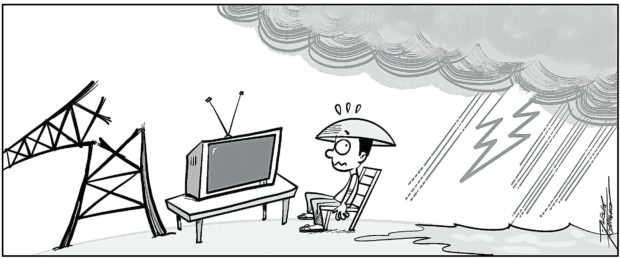
It took a while for Filipinos outside the areas of mass destruction to realize the extent of the misery inflicted by Supertyphoon Odette a week before Christmas. For days, reportage on what the typhoon had wrought in the Visayas and parts of Mindanao and Luzon could present only snippets of the tragedy; travel to the devastated regions was close to impossible and communication lines had been downed along with homes, buildings, transmission poles, trees.
It was yet another catastrophe, a perennial mark of life in this “Land of the Morning.” The Inquirer bureaus and others in the mainstream media strove mightily to present a broad picture of the aftermath of the typhoon, with its winds of 195 kilometers per hour (gusts reaching up to 240 kph) and rains more than what Supertyphoon Yolanda brought in 2013. It was truly discouraging, exacerbated by the central government’s sluggish pace as responder, as well as President Duterte’s initial remark about government coffers supposedly depleted by pandemic expenses. (Actually, there are funds to spend for relief and rehab, including those “parked” in certain departments.)
Online, Filipinos chafed at being in the dark about the gravity of the situation on the ground — for example, the frightening shortage of food and drinking water in the afflicted areas. The typhoon survivors themselves, on top of literally picking up the pieces, somehow managed to announce the absence of means by which information on their travails could reach the authorities, their kin, anyone.
It took members of the Makabayan bloc in the House of Representatives to formally put a finger on what was observably missing: information from the ABS-CBN Regional News Group, which would have quickly mobilized disaster response and helped ease the survivors’ suffering. In a press conference, Bayan Muna Rep. Eufemia Cullamat raised the network’s palpable absence early in the wake of Odette’s fury. She spoke from experience, being from Mindanao that is no stranger to all manner of disaster, and from awareness of the critical differences in reportage then and now.
Posting online, writer Jerry Grácio described the shuttered network’s once-tremendous and now-bygone reach: stations in key cities in the Visayas and Mindanao that gathered data 24 hours a day and reported crucial information in the prevailing languages even to far-flung areas through radio and television. All these were shut down when the network’s license expired in May 2020. With its broadcast operations clipped, the network concentrated on its digital and cable enterprises, to which a large segment of the population has no access.
Perhaps the government would have thumbed its nose at the public backlash over the House committee on legislative franchises’ subsequent 70-11 vote to kill the network’s application for franchise renewal, and, by now, masterfully filled the void created? Mr. Duterte had, after all, more than once aired threats to shut down the network, and then Palace mouthpiece Harry Roque had sniffed that its closure was no big deal because, he claimed snidely, that its main line was entertainment. But the Philippine News Agency was never of consequence in reportage in the past, and even now, despite running under the aegis of the billion-peso-funded Presidential Communications Operations Office.
Notwithstanding scaled-down resources and the hardships of getting to multiple Grounds Zero—Odette made landfall nine times in the course of its passage—the collective efforts of media networks are shining some light on not only the horrendous scale of destruction that gravely hampers the long-sought economic recovery from the pandemic, but also the measures urgently needed to save lives. The Inquirer reported on the steps that battered Surigao City rigorously undertook to prepare for Odette, and on its sad discovery that it had underestimated the typhoon’s strength. Reuters reported that weather forecasters had initially warned of “considerable damage” resulting from 165-kph winds but that there was no model on which they could have predicted Odette’s swift intensification. In the end, Odette “exceeded all our predictions,” said forecaster Nikos Peñaranda. He said the absence of real-time data and case studies of similar storms in the Asia-Pacific region made it difficult to predict just how much Odette would intensify.
Bayan Muna Rep. Carlos Zarate is calling on the Senate to fast-track House Bill No. 8990, which was passed by the chamber last March and mandates the establishment of permanent evacuation centers nationwide. The deputy minority leader is also loudly raising the necessity of making satellite phones part of the obligatory arsenal of local government units against disaster.
These are wise measures to make up for the palpable absences in disaster preparedness and the fatal turn of fierce weather disturbances.